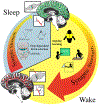Sleep and synaptic down-selection
- PMID: 30614089
- PMCID: PMC6612535
- DOI: 10.1111/ejn.14335
Sleep and synaptic down-selection
Abstract
The synaptic homeostasis hypothesis (SHY) proposes that sleep is an essential process needed by the brain to maintain the total amount of synaptic strength under control. SHY predicts that by the end of a waking day the synaptic connections of many neural circuits undergo a net increase in synaptic strength due to ongoing learning, which is mainly mediated by synaptic potentiation. Stronger synapses require more energy and supplies and are prone to saturation, creating the need for synaptic renormalization. Such renormalization should mainly occur during sleep, when the brain is disconnected from the environment and neural circuits can be broadly reactivated off-line to undergo a systematic but specific synaptic down-selection. In short, according to SHY sleep is the price to pay for waking plasticity, to avoid runaway potentiation, decreased signal-to-noise ratio, and impaired learning due to saturation. In this review, we briefly discuss the rationale of the hypothesis and recent supportive ultrastructural evidence obtained in our laboratory. We then examine recent studies by other groups showing the causal role of cortical slow waves and hippocampal sharp waves/ripples in sleep-dependent down-selection of neural activity and synaptic strength. Finally, we discuss some of the molecular mechanisms that could mediate synaptic weakening during sleep.
Keywords: homeostasis; serial electron microscopy; sleep; synapse; synaptic potentiation.
© 2019 Federation of European Neuroscience Societies and John Wiley & Sons Ltd.
Conflict of interest statement
Figures

References
Publication types
MeSH terms
Grants and funding
LinkOut - more resources
Full Text Sources

